Diabetes in Indigenous Australians: Colonization, Health, and Culture
VerifiedAdded on 2022/09/29
|9
|2030
|22
Essay
AI Summary
This essay provides a comprehensive overview of diabetes within Aboriginal and Torres Strait Islander populations in Australia. It explores the health issue, current statistics, historical context of colonization, and the impact of social determinants, including cultural implications and obstacles to addressing the issue. The essay highlights the role of factors like inherited vulnerability, behavior, nutrition, and psychological pressure in the rise of type 2 diabetes. It examines the impact of diabetes complications and the significant health disparities faced by Indigenous Australians, who are disproportionately affected by the disease. The essay discusses the historical and ongoing influences of colonization, cultural factors, and community structures on health outcomes. It also addresses the need for culturally sensitive healthcare, community involvement, and improved research to reduce the incidence and impact of diabetes within these communities.
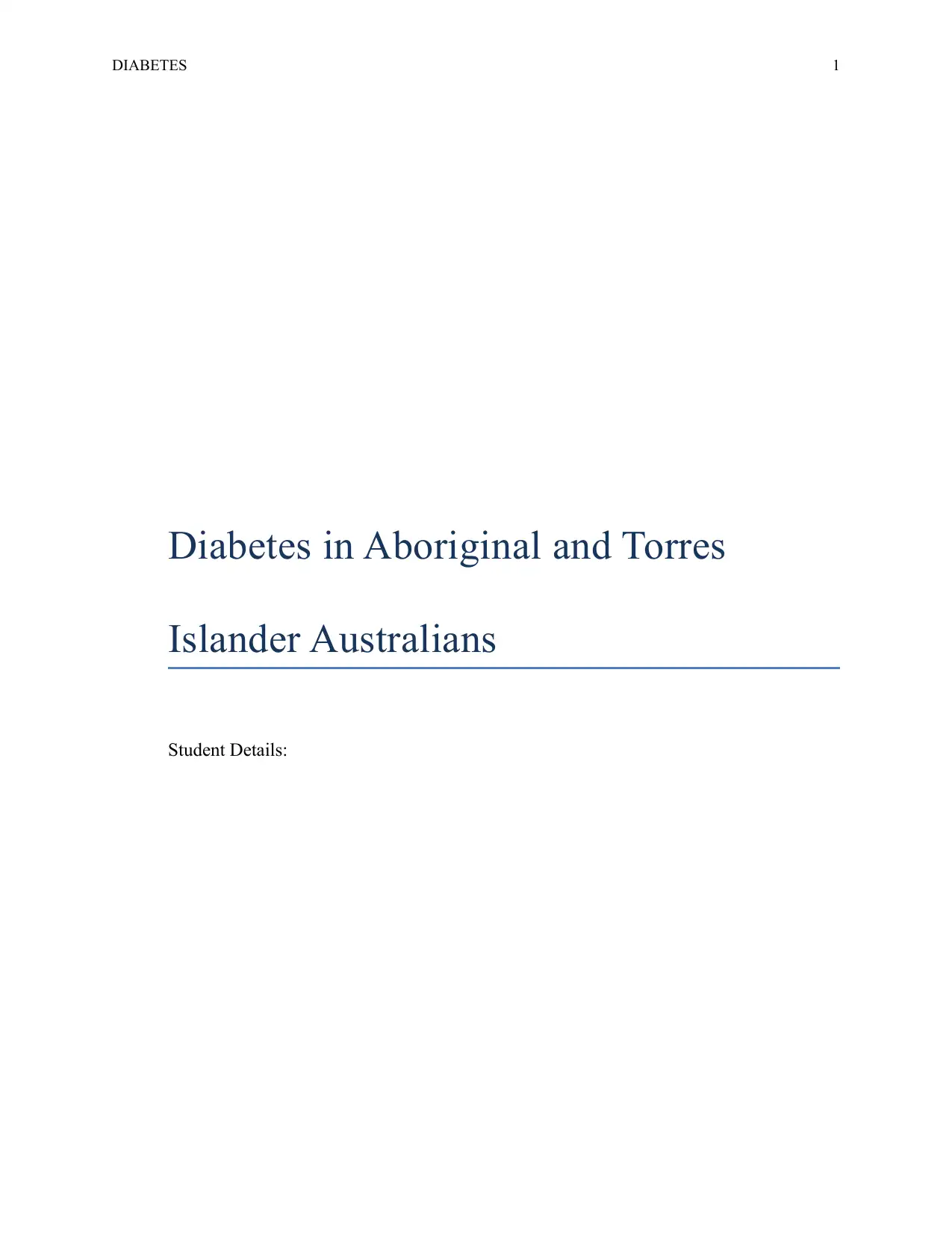
DIABETES 1
Diabetes in Aboriginal and Torres
Islander Australians
Student Details:
Diabetes in Aboriginal and Torres
Islander Australians
Student Details:
Paraphrase This Document
Need a fresh take? Get an instant paraphrase of this document with our AI Paraphraser
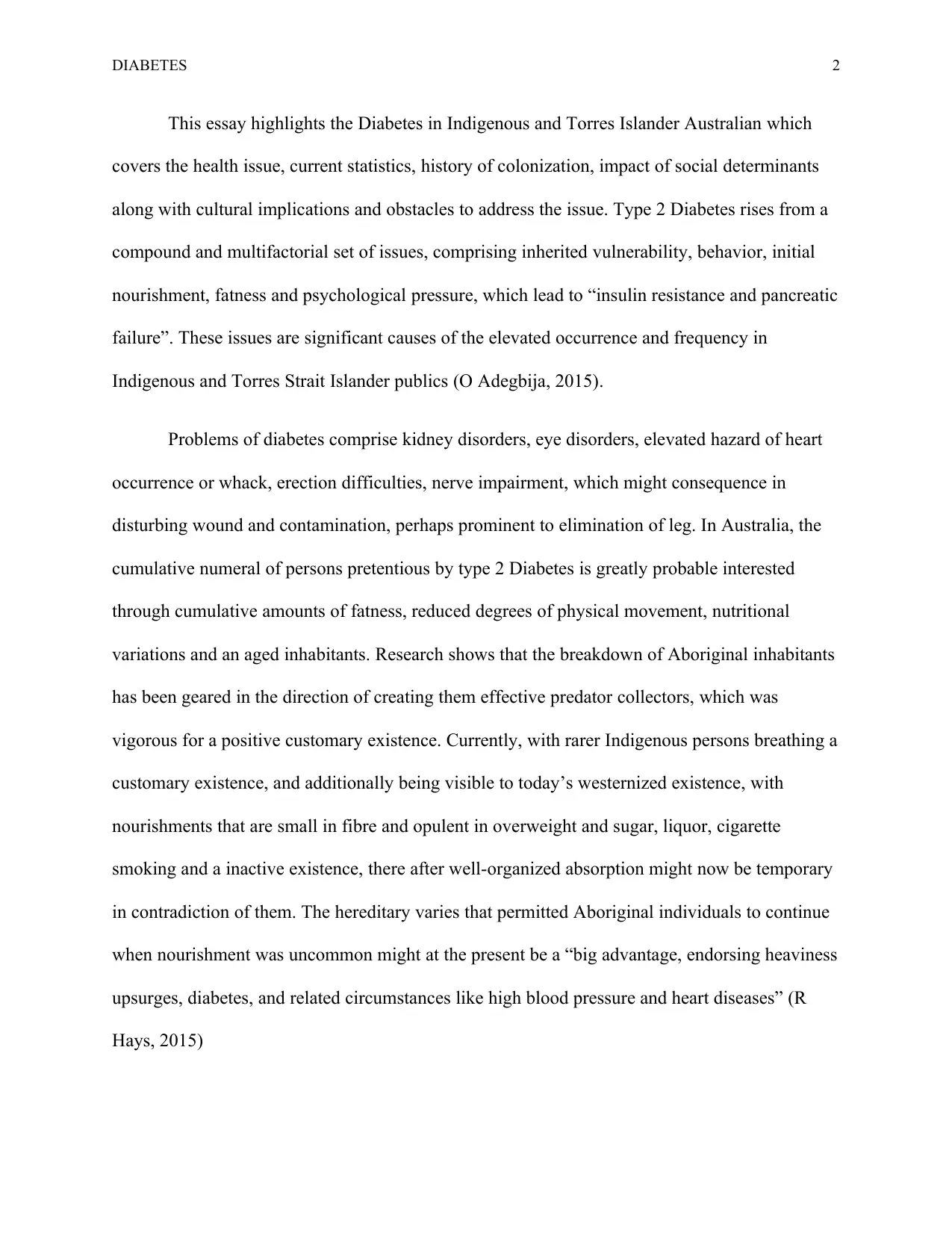
DIABETES 2
This essay highlights the Diabetes in Indigenous and Torres Islander Australian which
covers the health issue, current statistics, history of colonization, impact of social determinants
along with cultural implications and obstacles to address the issue. Type 2 Diabetes rises from a
compound and multifactorial set of issues, comprising inherited vulnerability, behavior, initial
nourishment, fatness and psychological pressure, which lead to “insulin resistance and pancreatic
failure”. These issues are significant causes of the elevated occurrence and frequency in
Indigenous and Torres Strait Islander publics (O Adegbija, 2015).
Problems of diabetes comprise kidney disorders, eye disorders, elevated hazard of heart
occurrence or whack, erection difficulties, nerve impairment, which might consequence in
disturbing wound and contamination, perhaps prominent to elimination of leg. In Australia, the
cumulative numeral of persons pretentious by type 2 Diabetes is greatly probable interested
through cumulative amounts of fatness, reduced degrees of physical movement, nutritional
variations and an aged inhabitants. Research shows that the breakdown of Aboriginal inhabitants
has been geared in the direction of creating them effective predator collectors, which was
vigorous for a positive customary existence. Currently, with rarer Indigenous persons breathing a
customary existence, and additionally being visible to today’s westernized existence, with
nourishments that are small in fibre and opulent in overweight and sugar, liquor, cigarette
smoking and a inactive existence, there after well-organized absorption might now be temporary
in contradiction of them. The hereditary varies that permitted Aboriginal individuals to continue
when nourishment was uncommon might at the present be a “big advantage, endorsing heaviness
upsurges, diabetes, and related circumstances like high blood pressure and heart diseases” (R
Hays, 2015)
This essay highlights the Diabetes in Indigenous and Torres Islander Australian which
covers the health issue, current statistics, history of colonization, impact of social determinants
along with cultural implications and obstacles to address the issue. Type 2 Diabetes rises from a
compound and multifactorial set of issues, comprising inherited vulnerability, behavior, initial
nourishment, fatness and psychological pressure, which lead to “insulin resistance and pancreatic
failure”. These issues are significant causes of the elevated occurrence and frequency in
Indigenous and Torres Strait Islander publics (O Adegbija, 2015).
Problems of diabetes comprise kidney disorders, eye disorders, elevated hazard of heart
occurrence or whack, erection difficulties, nerve impairment, which might consequence in
disturbing wound and contamination, perhaps prominent to elimination of leg. In Australia, the
cumulative numeral of persons pretentious by type 2 Diabetes is greatly probable interested
through cumulative amounts of fatness, reduced degrees of physical movement, nutritional
variations and an aged inhabitants. Research shows that the breakdown of Aboriginal inhabitants
has been geared in the direction of creating them effective predator collectors, which was
vigorous for a positive customary existence. Currently, with rarer Indigenous persons breathing a
customary existence, and additionally being visible to today’s westernized existence, with
nourishments that are small in fibre and opulent in overweight and sugar, liquor, cigarette
smoking and a inactive existence, there after well-organized absorption might now be temporary
in contradiction of them. The hereditary varies that permitted Aboriginal individuals to continue
when nourishment was uncommon might at the present be a “big advantage, endorsing heaviness
upsurges, diabetes, and related circumstances like high blood pressure and heart diseases” (R
Hays, 2015)
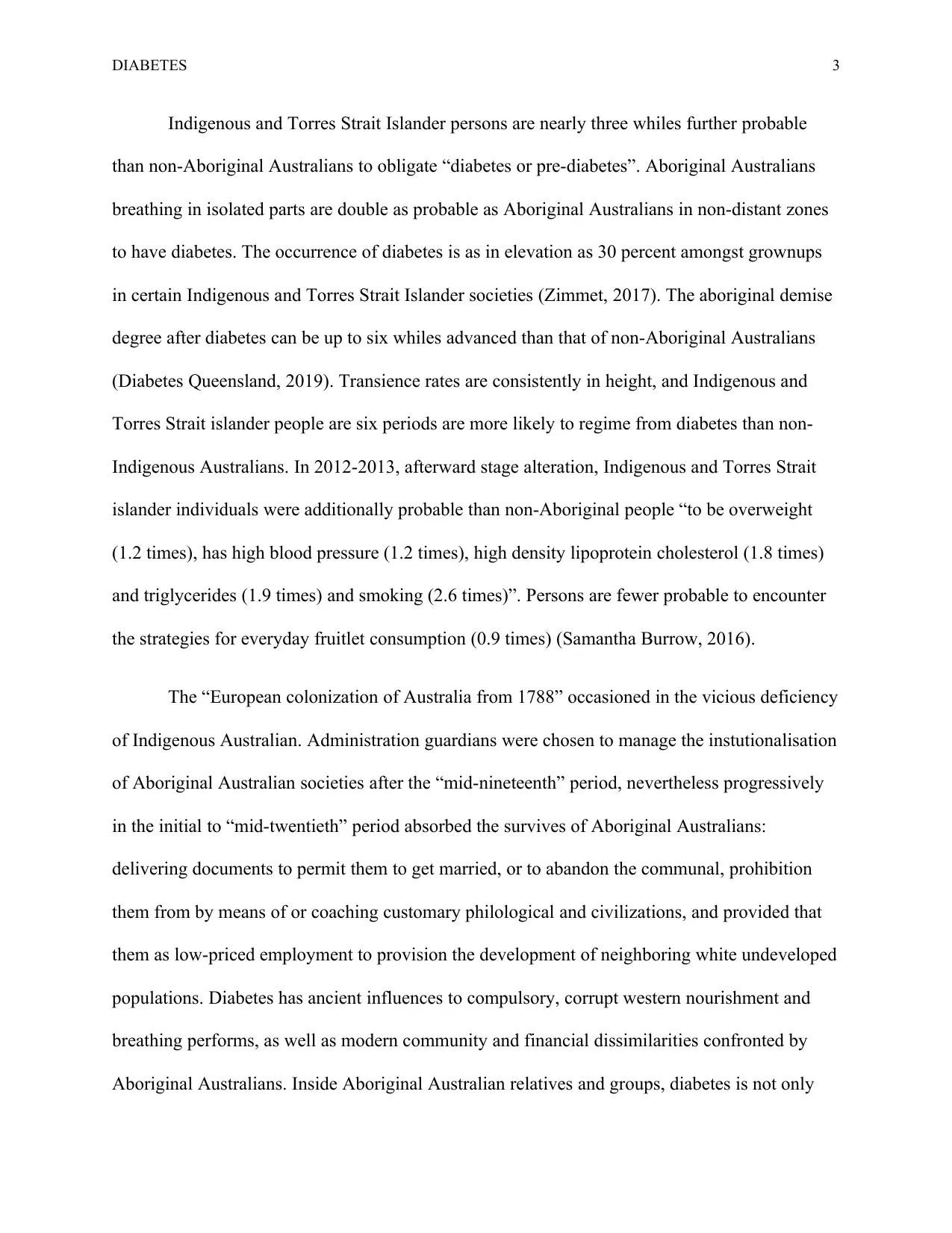
DIABETES 3
Indigenous and Torres Strait Islander persons are nearly three whiles further probable
than non-Aboriginal Australians to obligate “diabetes or pre-diabetes”. Aboriginal Australians
breathing in isolated parts are double as probable as Aboriginal Australians in non-distant zones
to have diabetes. The occurrence of diabetes is as in elevation as 30 percent amongst grownups
in certain Indigenous and Torres Strait Islander societies (Zimmet, 2017). The aboriginal demise
degree after diabetes can be up to six whiles advanced than that of non-Aboriginal Australians
(Diabetes Queensland, 2019). Transience rates are consistently in height, and Indigenous and
Torres Strait islander people are six periods are more likely to regime from diabetes than non-
Indigenous Australians. In 2012-2013, afterward stage alteration, Indigenous and Torres Strait
islander individuals were additionally probable than non-Aboriginal people “to be overweight
(1.2 times), has high blood pressure (1.2 times), high density lipoprotein cholesterol (1.8 times)
and triglycerides (1.9 times) and smoking (2.6 times)”. Persons are fewer probable to encounter
the strategies for everyday fruitlet consumption (0.9 times) (Samantha Burrow, 2016).
The “European colonization of Australia from 1788” occasioned in the vicious deficiency
of Indigenous Australian. Administration guardians were chosen to manage the instutionalisation
of Aboriginal Australian societies after the “mid-nineteenth” period, nevertheless progressively
in the initial to “mid-twentieth” period absorbed the survives of Aboriginal Australians:
delivering documents to permit them to get married, or to abandon the communal, prohibition
them from by means of or coaching customary philological and civilizations, and provided that
them as low-priced employment to provision the development of neighboring white undeveloped
populations. Diabetes has ancient influences to compulsory, corrupt western nourishment and
breathing performs, as well as modern community and financial dissimilarities confronted by
Aboriginal Australians. Inside Aboriginal Australian relatives and groups, diabetes is not only
Indigenous and Torres Strait Islander persons are nearly three whiles further probable
than non-Aboriginal Australians to obligate “diabetes or pre-diabetes”. Aboriginal Australians
breathing in isolated parts are double as probable as Aboriginal Australians in non-distant zones
to have diabetes. The occurrence of diabetes is as in elevation as 30 percent amongst grownups
in certain Indigenous and Torres Strait Islander societies (Zimmet, 2017). The aboriginal demise
degree after diabetes can be up to six whiles advanced than that of non-Aboriginal Australians
(Diabetes Queensland, 2019). Transience rates are consistently in height, and Indigenous and
Torres Strait islander people are six periods are more likely to regime from diabetes than non-
Indigenous Australians. In 2012-2013, afterward stage alteration, Indigenous and Torres Strait
islander individuals were additionally probable than non-Aboriginal people “to be overweight
(1.2 times), has high blood pressure (1.2 times), high density lipoprotein cholesterol (1.8 times)
and triglycerides (1.9 times) and smoking (2.6 times)”. Persons are fewer probable to encounter
the strategies for everyday fruitlet consumption (0.9 times) (Samantha Burrow, 2016).
The “European colonization of Australia from 1788” occasioned in the vicious deficiency
of Indigenous Australian. Administration guardians were chosen to manage the instutionalisation
of Aboriginal Australian societies after the “mid-nineteenth” period, nevertheless progressively
in the initial to “mid-twentieth” period absorbed the survives of Aboriginal Australians:
delivering documents to permit them to get married, or to abandon the communal, prohibition
them from by means of or coaching customary philological and civilizations, and provided that
them as low-priced employment to provision the development of neighboring white undeveloped
populations. Diabetes has ancient influences to compulsory, corrupt western nourishment and
breathing performs, as well as modern community and financial dissimilarities confronted by
Aboriginal Australians. Inside Aboriginal Australian relatives and groups, diabetes is not only
⊘ This is a preview!⊘
Do you want full access?
Subscribe today to unlock all pages.

Trusted by 1+ million students worldwide
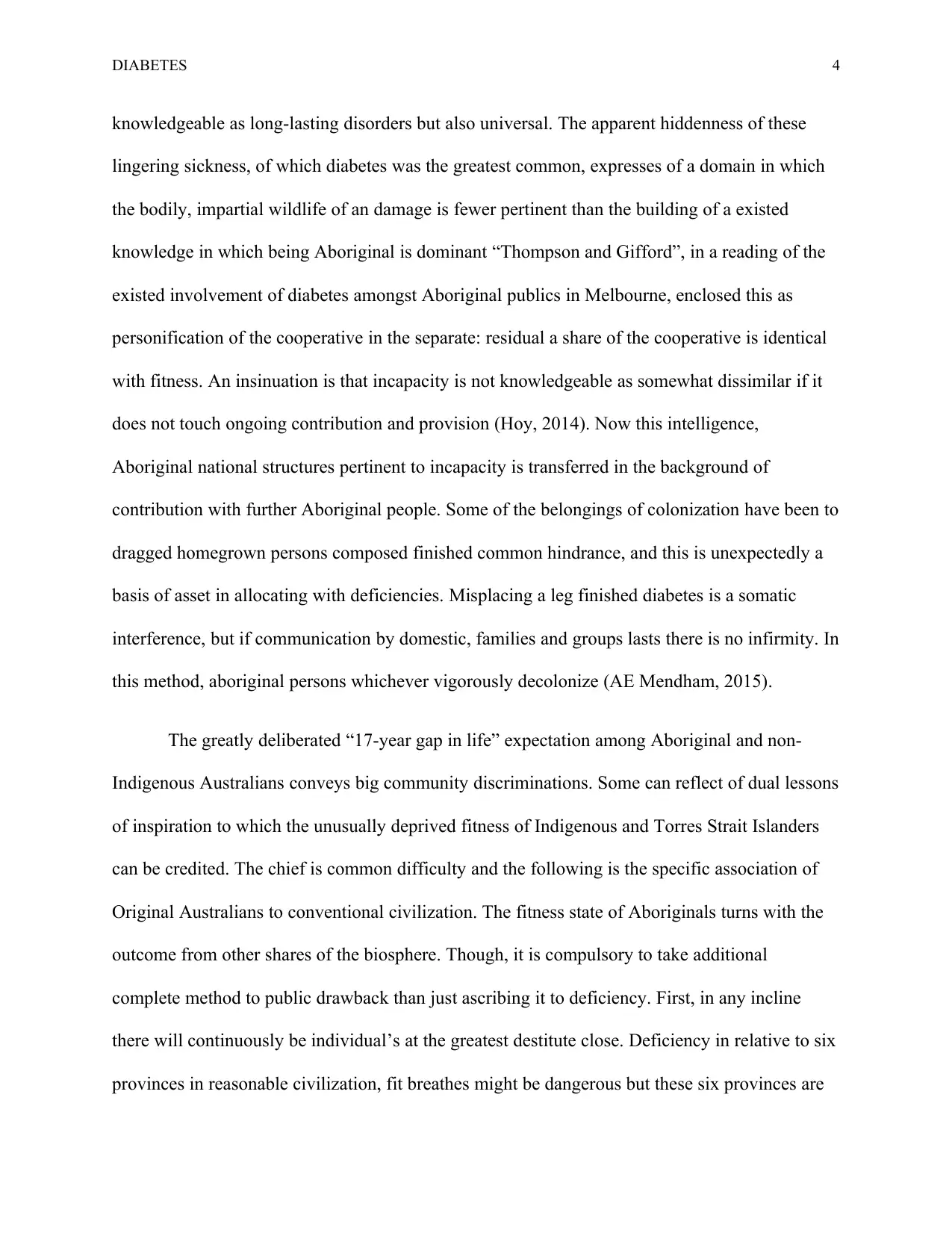
DIABETES 4
knowledgeable as long-lasting disorders but also universal. The apparent hiddenness of these
lingering sickness, of which diabetes was the greatest common, expresses of a domain in which
the bodily, impartial wildlife of an damage is fewer pertinent than the building of a existed
knowledge in which being Aboriginal is dominant “Thompson and Gifford”, in a reading of the
existed involvement of diabetes amongst Aboriginal publics in Melbourne, enclosed this as
personification of the cooperative in the separate: residual a share of the cooperative is identical
with fitness. An insinuation is that incapacity is not knowledgeable as somewhat dissimilar if it
does not touch ongoing contribution and provision (Hoy, 2014). Now this intelligence,
Aboriginal national structures pertinent to incapacity is transferred in the background of
contribution with further Aboriginal people. Some of the belongings of colonization have been to
dragged homegrown persons composed finished common hindrance, and this is unexpectedly a
basis of asset in allocating with deficiencies. Misplacing a leg finished diabetes is a somatic
interference, but if communication by domestic, families and groups lasts there is no infirmity. In
this method, aboriginal persons whichever vigorously decolonize (AE Mendham, 2015).
The greatly deliberated “17-year gap in life” expectation among Aboriginal and non-
Indigenous Australians conveys big community discriminations. Some can reflect of dual lessons
of inspiration to which the unusually deprived fitness of Indigenous and Torres Strait Islanders
can be credited. The chief is common difficulty and the following is the specific association of
Original Australians to conventional civilization. The fitness state of Aboriginals turns with the
outcome from other shares of the biosphere. Though, it is compulsory to take additional
complete method to public drawback than just ascribing it to deficiency. First, in any incline
there will continuously be individual’s at the greatest destitute close. Deficiency in relative to six
provinces in reasonable civilization, fit breathes might be dangerous but these six provinces are
knowledgeable as long-lasting disorders but also universal. The apparent hiddenness of these
lingering sickness, of which diabetes was the greatest common, expresses of a domain in which
the bodily, impartial wildlife of an damage is fewer pertinent than the building of a existed
knowledge in which being Aboriginal is dominant “Thompson and Gifford”, in a reading of the
existed involvement of diabetes amongst Aboriginal publics in Melbourne, enclosed this as
personification of the cooperative in the separate: residual a share of the cooperative is identical
with fitness. An insinuation is that incapacity is not knowledgeable as somewhat dissimilar if it
does not touch ongoing contribution and provision (Hoy, 2014). Now this intelligence,
Aboriginal national structures pertinent to incapacity is transferred in the background of
contribution with further Aboriginal people. Some of the belongings of colonization have been to
dragged homegrown persons composed finished common hindrance, and this is unexpectedly a
basis of asset in allocating with deficiencies. Misplacing a leg finished diabetes is a somatic
interference, but if communication by domestic, families and groups lasts there is no infirmity. In
this method, aboriginal persons whichever vigorously decolonize (AE Mendham, 2015).
The greatly deliberated “17-year gap in life” expectation among Aboriginal and non-
Indigenous Australians conveys big community discriminations. Some can reflect of dual lessons
of inspiration to which the unusually deprived fitness of Indigenous and Torres Strait Islanders
can be credited. The chief is common difficulty and the following is the specific association of
Original Australians to conventional civilization. The fitness state of Aboriginals turns with the
outcome from other shares of the biosphere. Though, it is compulsory to take additional
complete method to public drawback than just ascribing it to deficiency. First, in any incline
there will continuously be individual’s at the greatest destitute close. Deficiency in relative to six
provinces in reasonable civilization, fit breathes might be dangerous but these six provinces are
Paraphrase This Document
Need a fresh take? Get an instant paraphrase of this document with our AI Paraphraser
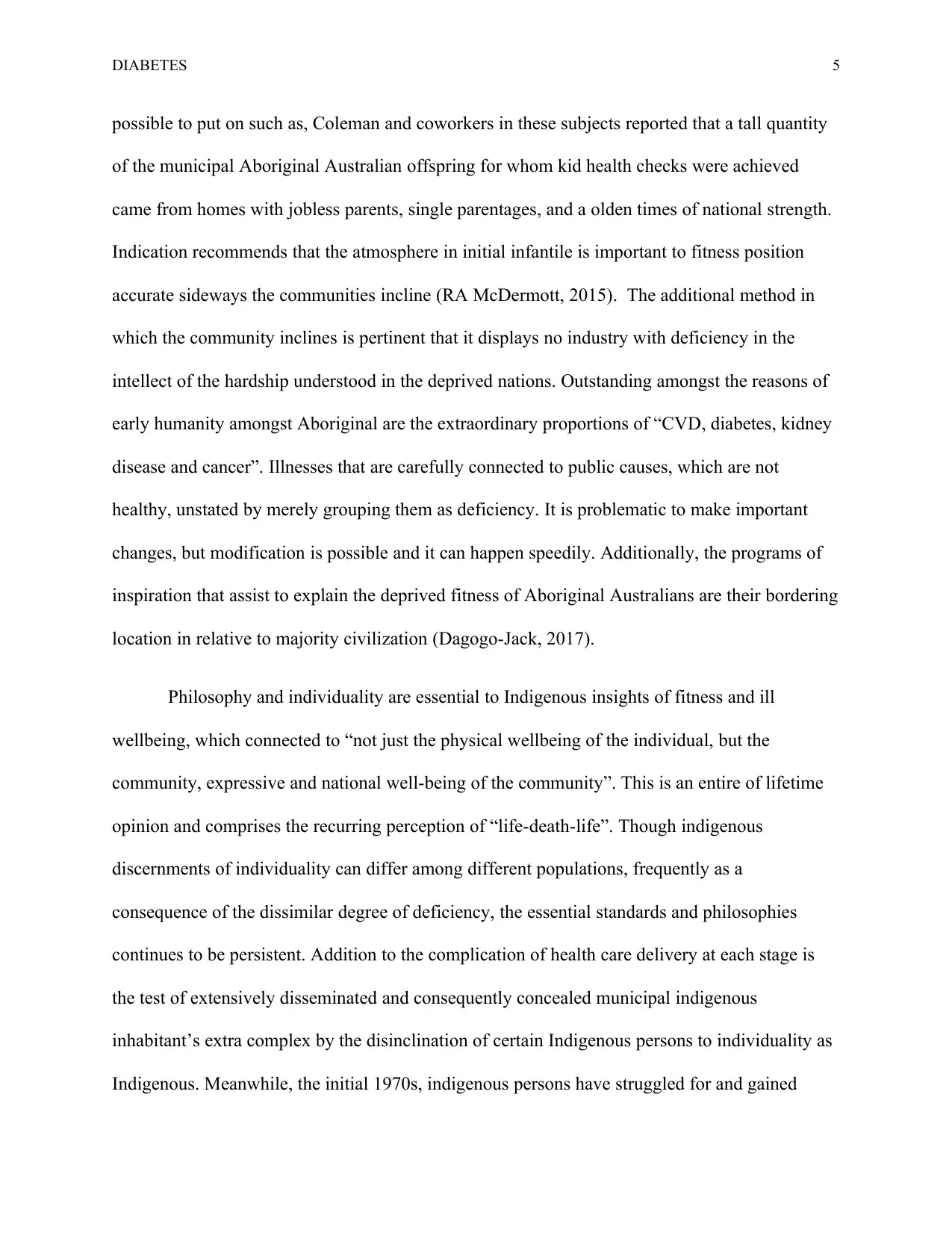
DIABETES 5
possible to put on such as, Coleman and coworkers in these subjects reported that a tall quantity
of the municipal Aboriginal Australian offspring for whom kid health checks were achieved
came from homes with jobless parents, single parentages, and a olden times of national strength.
Indication recommends that the atmosphere in initial infantile is important to fitness position
accurate sideways the communities incline (RA McDermott, 2015). The additional method in
which the community inclines is pertinent that it displays no industry with deficiency in the
intellect of the hardship understood in the deprived nations. Outstanding amongst the reasons of
early humanity amongst Aboriginal are the extraordinary proportions of “CVD, diabetes, kidney
disease and cancer”. Illnesses that are carefully connected to public causes, which are not
healthy, unstated by merely grouping them as deficiency. It is problematic to make important
changes, but modification is possible and it can happen speedily. Additionally, the programs of
inspiration that assist to explain the deprived fitness of Aboriginal Australians are their bordering
location in relative to majority civilization (Dagogo-Jack, 2017).
Philosophy and individuality are essential to Indigenous insights of fitness and ill
wellbeing, which connected to “not just the physical wellbeing of the individual, but the
community, expressive and national well-being of the community”. This is an entire of lifetime
opinion and comprises the recurring perception of “life-death-life”. Though indigenous
discernments of individuality can differ among different populations, frequently as a
consequence of the dissimilar degree of deficiency, the essential standards and philosophies
continues to be persistent. Addition to the complication of health care delivery at each stage is
the test of extensively disseminated and consequently concealed municipal indigenous
inhabitant’s extra complex by the disinclination of certain Indigenous persons to individuality as
Indigenous. Meanwhile, the initial 1970s, indigenous persons have struggled for and gained
possible to put on such as, Coleman and coworkers in these subjects reported that a tall quantity
of the municipal Aboriginal Australian offspring for whom kid health checks were achieved
came from homes with jobless parents, single parentages, and a olden times of national strength.
Indication recommends that the atmosphere in initial infantile is important to fitness position
accurate sideways the communities incline (RA McDermott, 2015). The additional method in
which the community inclines is pertinent that it displays no industry with deficiency in the
intellect of the hardship understood in the deprived nations. Outstanding amongst the reasons of
early humanity amongst Aboriginal are the extraordinary proportions of “CVD, diabetes, kidney
disease and cancer”. Illnesses that are carefully connected to public causes, which are not
healthy, unstated by merely grouping them as deficiency. It is problematic to make important
changes, but modification is possible and it can happen speedily. Additionally, the programs of
inspiration that assist to explain the deprived fitness of Aboriginal Australians are their bordering
location in relative to majority civilization (Dagogo-Jack, 2017).
Philosophy and individuality are essential to Indigenous insights of fitness and ill
wellbeing, which connected to “not just the physical wellbeing of the individual, but the
community, expressive and national well-being of the community”. This is an entire of lifetime
opinion and comprises the recurring perception of “life-death-life”. Though indigenous
discernments of individuality can differ among different populations, frequently as a
consequence of the dissimilar degree of deficiency, the essential standards and philosophies
continues to be persistent. Addition to the complication of health care delivery at each stage is
the test of extensively disseminated and consequently concealed municipal indigenous
inhabitant’s extra complex by the disinclination of certain Indigenous persons to individuality as
Indigenous. Meanwhile, the initial 1970s, indigenous persons have struggled for and gained
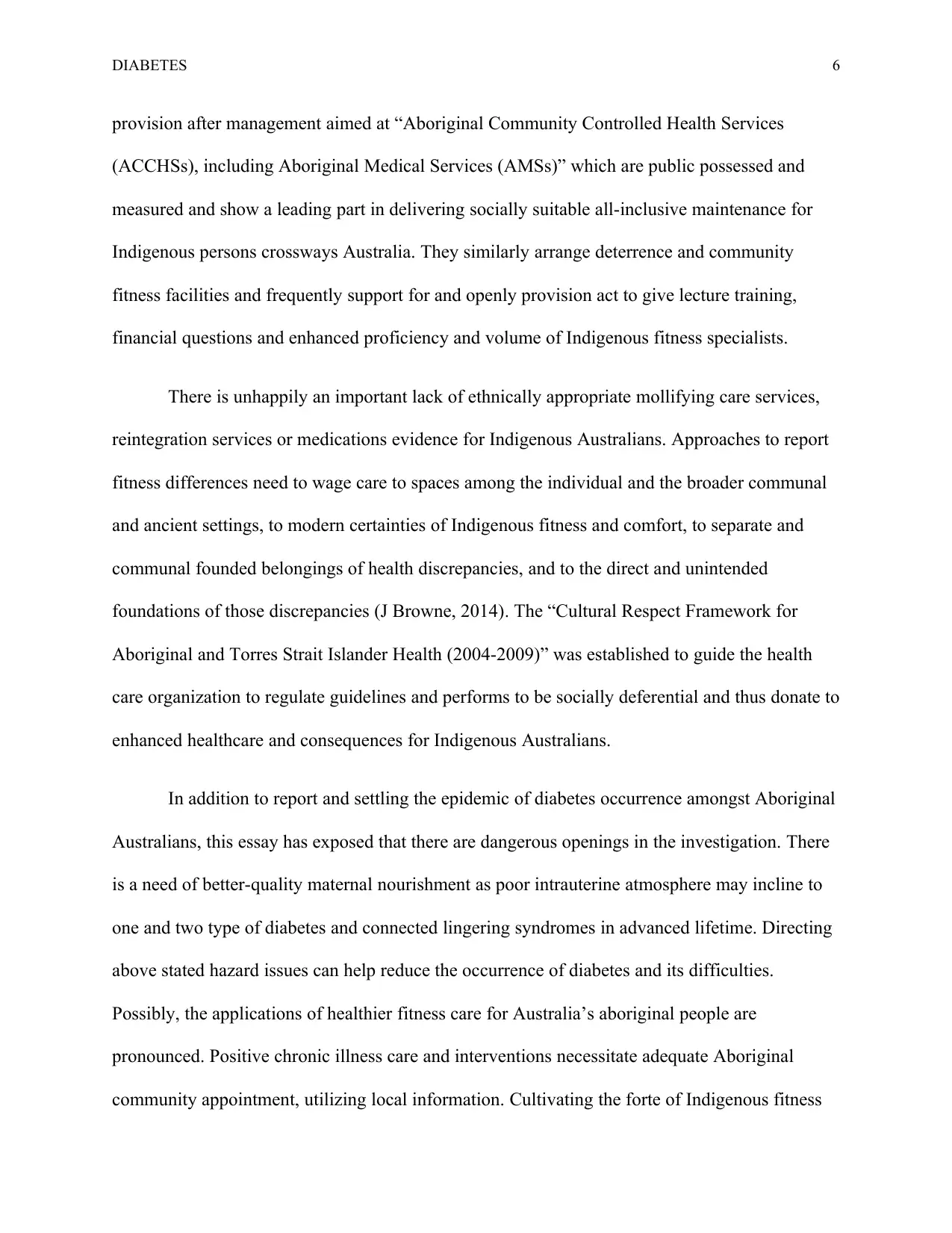
DIABETES 6
provision after management aimed at “Aboriginal Community Controlled Health Services
(ACCHSs), including Aboriginal Medical Services (AMSs)” which are public possessed and
measured and show a leading part in delivering socially suitable all-inclusive maintenance for
Indigenous persons crossways Australia. They similarly arrange deterrence and community
fitness facilities and frequently support for and openly provision act to give lecture training,
financial questions and enhanced proficiency and volume of Indigenous fitness specialists.
There is unhappily an important lack of ethnically appropriate mollifying care services,
reintegration services or medications evidence for Indigenous Australians. Approaches to report
fitness differences need to wage care to spaces among the individual and the broader communal
and ancient settings, to modern certainties of Indigenous fitness and comfort, to separate and
communal founded belongings of health discrepancies, and to the direct and unintended
foundations of those discrepancies (J Browne, 2014). The “Cultural Respect Framework for
Aboriginal and Torres Strait Islander Health (2004-2009)” was established to guide the health
care organization to regulate guidelines and performs to be socially deferential and thus donate to
enhanced healthcare and consequences for Indigenous Australians.
In addition to report and settling the epidemic of diabetes occurrence amongst Aboriginal
Australians, this essay has exposed that there are dangerous openings in the investigation. There
is a need of better-quality maternal nourishment as poor intrauterine atmosphere may incline to
one and two type of diabetes and connected lingering syndromes in advanced lifetime. Directing
above stated hazard issues can help reduce the occurrence of diabetes and its difficulties.
Possibly, the applications of healthier fitness care for Australia’s aboriginal people are
pronounced. Positive chronic illness care and interventions necessitate adequate Aboriginal
community appointment, utilizing local information. Cultivating the forte of Indigenous fitness
provision after management aimed at “Aboriginal Community Controlled Health Services
(ACCHSs), including Aboriginal Medical Services (AMSs)” which are public possessed and
measured and show a leading part in delivering socially suitable all-inclusive maintenance for
Indigenous persons crossways Australia. They similarly arrange deterrence and community
fitness facilities and frequently support for and openly provision act to give lecture training,
financial questions and enhanced proficiency and volume of Indigenous fitness specialists.
There is unhappily an important lack of ethnically appropriate mollifying care services,
reintegration services or medications evidence for Indigenous Australians. Approaches to report
fitness differences need to wage care to spaces among the individual and the broader communal
and ancient settings, to modern certainties of Indigenous fitness and comfort, to separate and
communal founded belongings of health discrepancies, and to the direct and unintended
foundations of those discrepancies (J Browne, 2014). The “Cultural Respect Framework for
Aboriginal and Torres Strait Islander Health (2004-2009)” was established to guide the health
care organization to regulate guidelines and performs to be socially deferential and thus donate to
enhanced healthcare and consequences for Indigenous Australians.
In addition to report and settling the epidemic of diabetes occurrence amongst Aboriginal
Australians, this essay has exposed that there are dangerous openings in the investigation. There
is a need of better-quality maternal nourishment as poor intrauterine atmosphere may incline to
one and two type of diabetes and connected lingering syndromes in advanced lifetime. Directing
above stated hazard issues can help reduce the occurrence of diabetes and its difficulties.
Possibly, the applications of healthier fitness care for Australia’s aboriginal people are
pronounced. Positive chronic illness care and interventions necessitate adequate Aboriginal
community appointment, utilizing local information. Cultivating the forte of Indigenous fitness
⊘ This is a preview!⊘
Do you want full access?
Subscribe today to unlock all pages.

Trusted by 1+ million students worldwide
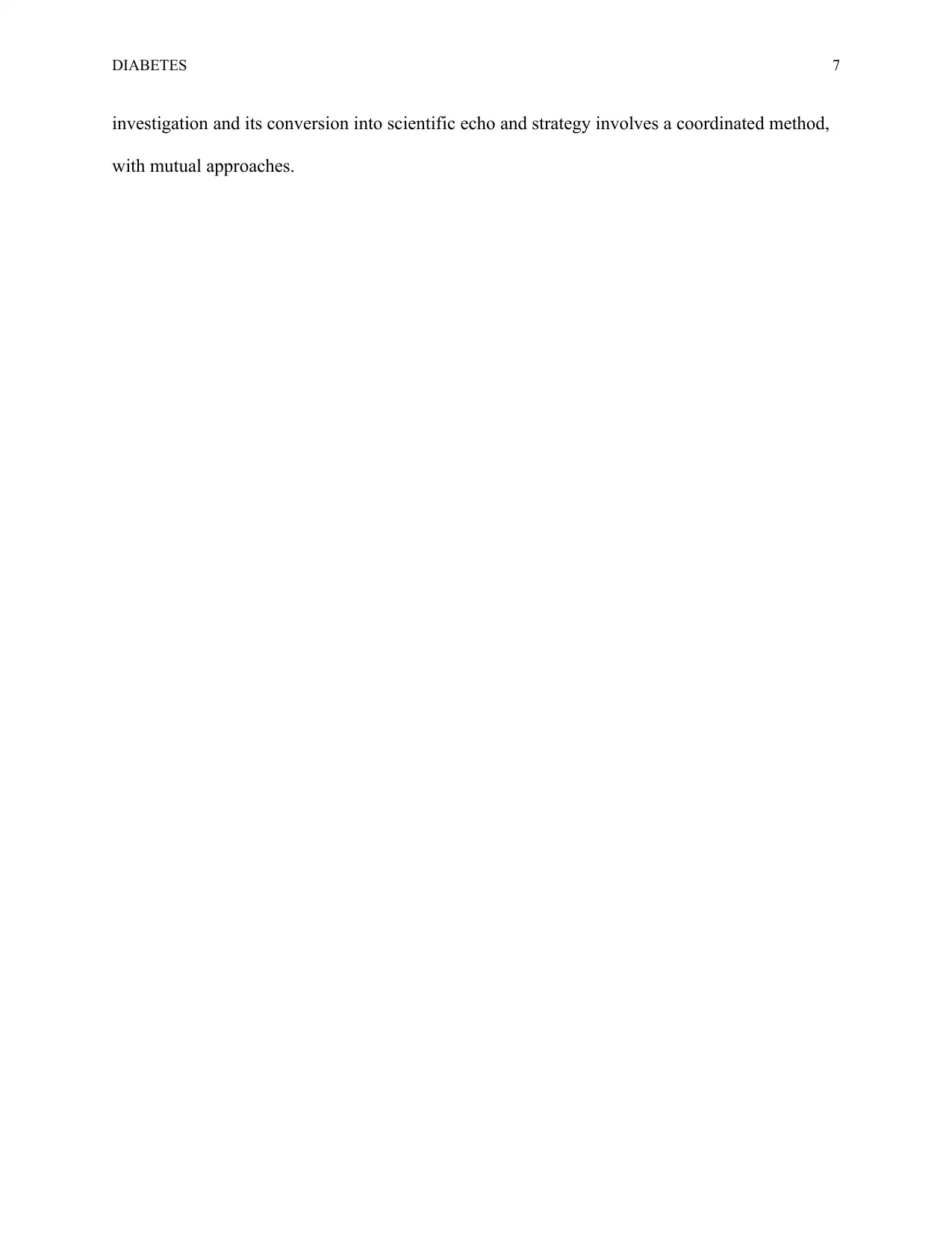
DIABETES 7
investigation and its conversion into scientific echo and strategy involves a coordinated method,
with mutual approaches.
investigation and its conversion into scientific echo and strategy involves a coordinated method,
with mutual approaches.
Paraphrase This Document
Need a fresh take? Get an instant paraphrase of this document with our AI Paraphraser
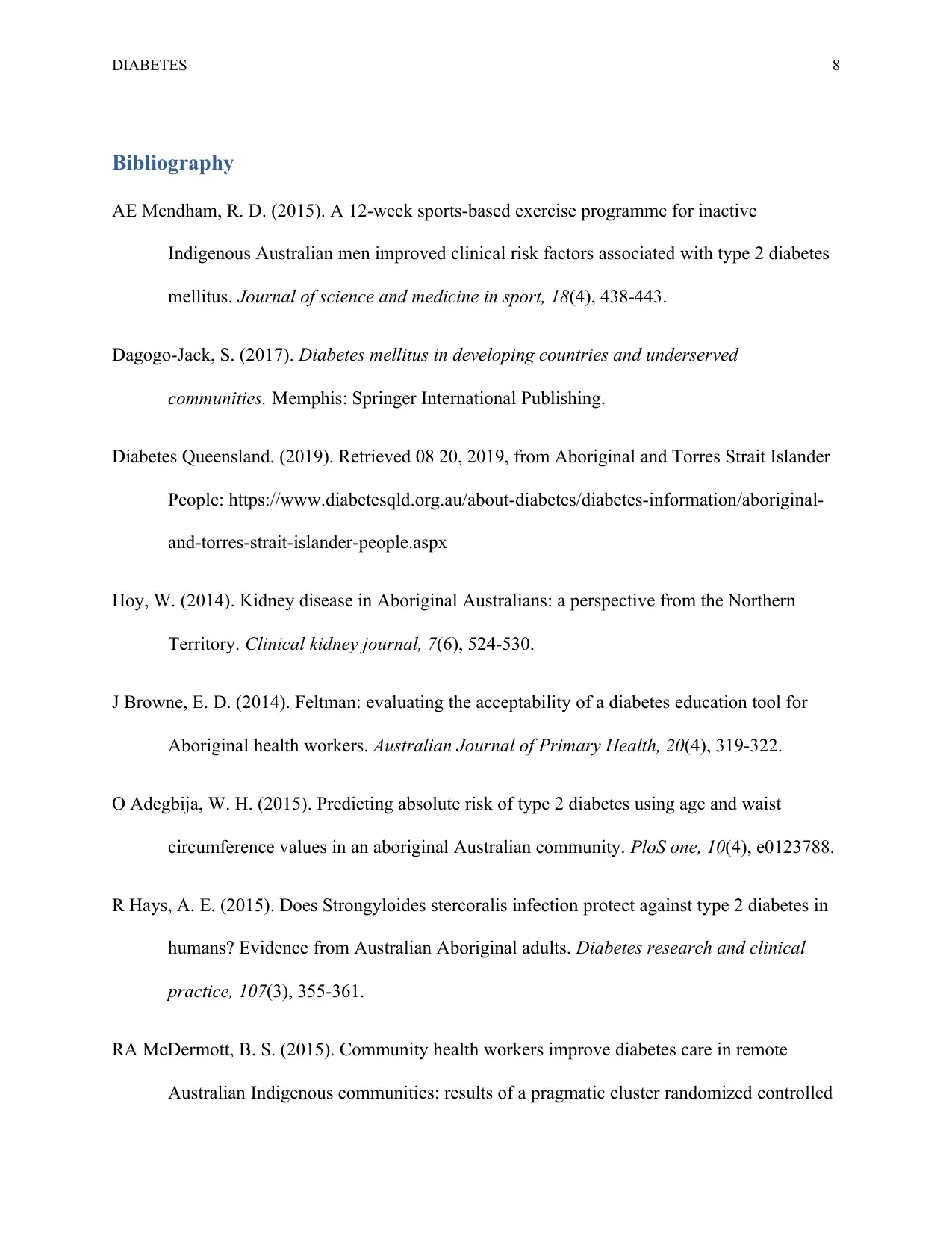
DIABETES 8
Bibliography
AE Mendham, R. D. (2015). A 12-week sports-based exercise programme for inactive
Indigenous Australian men improved clinical risk factors associated with type 2 diabetes
mellitus. Journal of science and medicine in sport, 18(4), 438-443.
Dagogo-Jack, S. (2017). Diabetes mellitus in developing countries and underserved
communities. Memphis: Springer International Publishing.
Diabetes Queensland. (2019). Retrieved 08 20, 2019, from Aboriginal and Torres Strait Islander
People: https://www.diabetesqld.org.au/about-diabetes/diabetes-information/aboriginal-
and-torres-strait-islander-people.aspx
Hoy, W. (2014). Kidney disease in Aboriginal Australians: a perspective from the Northern
Territory. Clinical kidney journal, 7(6), 524-530.
J Browne, E. D. (2014). Feltman: evaluating the acceptability of a diabetes education tool for
Aboriginal health workers. Australian Journal of Primary Health, 20(4), 319-322.
O Adegbija, W. H. (2015). Predicting absolute risk of type 2 diabetes using age and waist
circumference values in an aboriginal Australian community. PloS one, 10(4), e0123788.
R Hays, A. E. (2015). Does Strongyloides stercoralis infection protect against type 2 diabetes in
humans? Evidence from Australian Aboriginal adults. Diabetes research and clinical
practice, 107(3), 355-361.
RA McDermott, B. S. (2015). Community health workers improve diabetes care in remote
Australian Indigenous communities: results of a pragmatic cluster randomized controlled
Bibliography
AE Mendham, R. D. (2015). A 12-week sports-based exercise programme for inactive
Indigenous Australian men improved clinical risk factors associated with type 2 diabetes
mellitus. Journal of science and medicine in sport, 18(4), 438-443.
Dagogo-Jack, S. (2017). Diabetes mellitus in developing countries and underserved
communities. Memphis: Springer International Publishing.
Diabetes Queensland. (2019). Retrieved 08 20, 2019, from Aboriginal and Torres Strait Islander
People: https://www.diabetesqld.org.au/about-diabetes/diabetes-information/aboriginal-
and-torres-strait-islander-people.aspx
Hoy, W. (2014). Kidney disease in Aboriginal Australians: a perspective from the Northern
Territory. Clinical kidney journal, 7(6), 524-530.
J Browne, E. D. (2014). Feltman: evaluating the acceptability of a diabetes education tool for
Aboriginal health workers. Australian Journal of Primary Health, 20(4), 319-322.
O Adegbija, W. H. (2015). Predicting absolute risk of type 2 diabetes using age and waist
circumference values in an aboriginal Australian community. PloS one, 10(4), e0123788.
R Hays, A. E. (2015). Does Strongyloides stercoralis infection protect against type 2 diabetes in
humans? Evidence from Australian Aboriginal adults. Diabetes research and clinical
practice, 107(3), 355-361.
RA McDermott, B. S. (2015). Community health workers improve diabetes care in remote
Australian Indigenous communities: results of a pragmatic cluster randomized controlled
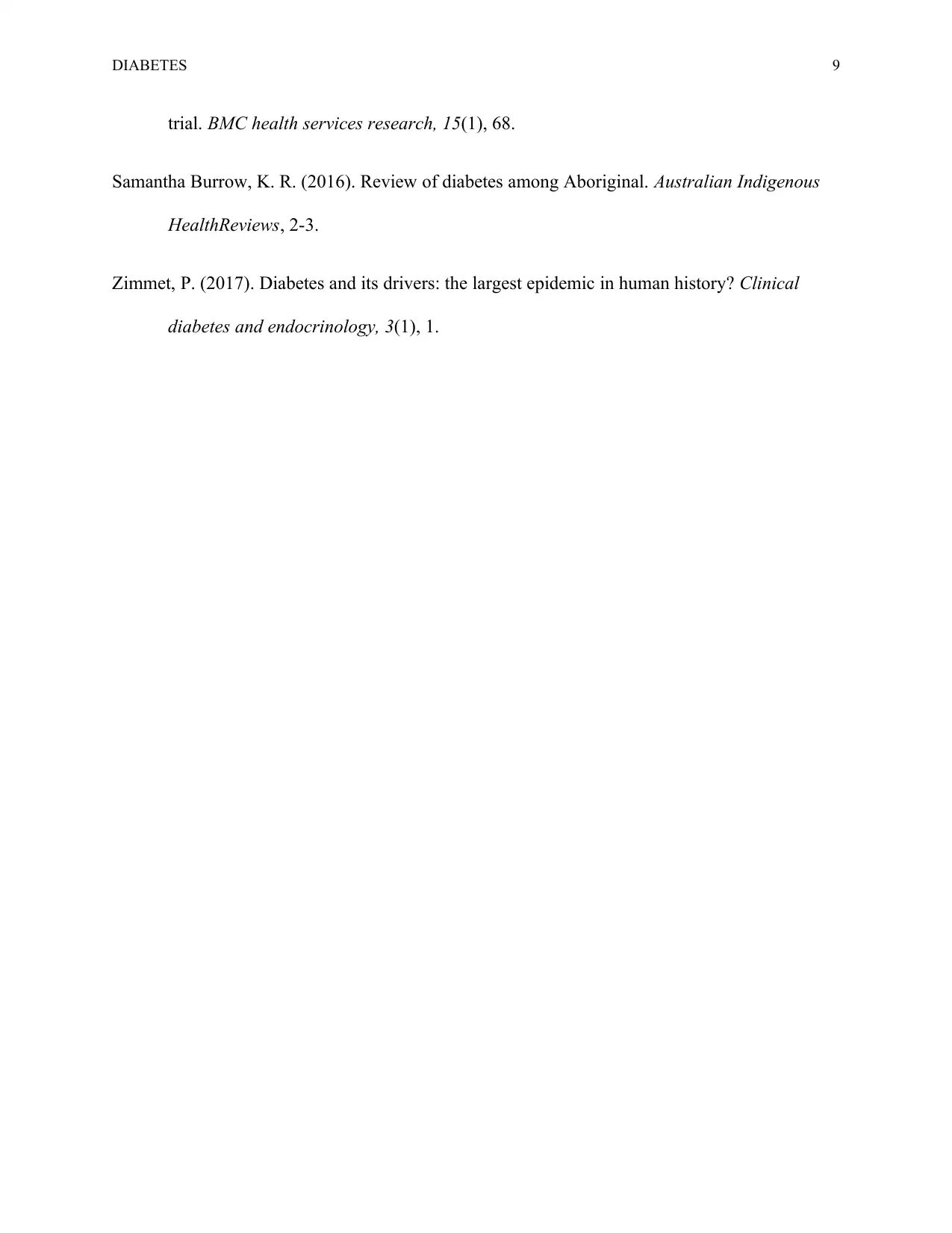
DIABETES 9
trial. BMC health services research, 15(1), 68.
Samantha Burrow, K. R. (2016). Review of diabetes among Aboriginal. Australian Indigenous
HealthReviews, 2-3.
Zimmet, P. (2017). Diabetes and its drivers: the largest epidemic in human history? Clinical
diabetes and endocrinology, 3(1), 1.
trial. BMC health services research, 15(1), 68.
Samantha Burrow, K. R. (2016). Review of diabetes among Aboriginal. Australian Indigenous
HealthReviews, 2-3.
Zimmet, P. (2017). Diabetes and its drivers: the largest epidemic in human history? Clinical
diabetes and endocrinology, 3(1), 1.
⊘ This is a preview!⊘
Do you want full access?
Subscribe today to unlock all pages.

Trusted by 1+ million students worldwide
1 out of 9
Related Documents
Your All-in-One AI-Powered Toolkit for Academic Success.
+13062052269
info@desklib.com
Available 24*7 on WhatsApp / Email
![[object Object]](/_next/static/media/star-bottom.7253800d.svg)
Unlock your academic potential
Copyright © 2020–2025 A2Z Services. All Rights Reserved. Developed and managed by ZUCOL.





